
Back in 2021, news outlets around the world announced a scandal involving Canadian government schools and missing indigenous children. Starting in the 1800s, Canada built and opened a series of boarding schools where children from local native people could be educated or, more accurately, assimilated into modern Western culture. A majority of these institutions were operated by the Roman Catholic church and, before they were shut down toward the end of the twentieth century, tens of thousands of children were taken from their families, compelled to speak English or French, taught Christianity, and required to dress according to European styles.
Even if those involved had the best of motives, families and students were harmed by these institutions. A number of former students have even reported being subject to physical and sexual abuse. The scandal of 2021, however, was a matter of missing bodies.
Over the century or so that the schools were in operation, around 4,000 students died of tuberculosis and similar diseases. Reports claimed that ground-penetrating radar had shown that hundreds, if not thousands of children, were simply and unceremoniously dumped in mass graves, some perhaps the victims of murder.
Papers across the English-speaking world reported on these mass graves. The Canadian government issued a spate of apologies. Since the majority of these schools were run by the Roman Catholic Church, the pope was urged to apologize. The backlash became violent. In retaliation against the priests and nuns who purportedly had performed this evil, dozens of churches across Canada were desecrated or burned. As one civil rights activist said of the churches, “Burn it all down.” The arson even spread beyond any connection to white, Catholic churches. Many buildings burnt belonged to immigrant Christian communities. Others weren’t Roman Catholic churches at all.
Today, however, at several of the sites where the burials were confidently asserted to have taken place, no physical evidence of human remains has been found. An excavation at the site of Pine Creek Indian Reservation School turned up nothing. When academics began to point out the lack of evidence before the new information was released to the public, they were shouted down with accusations of “denialism.”
In other words, the immediate assumption of guilt had far more to do with the power of ideology than a preponderance of evidence. The realities of this collision of cultures were far less important than the pre-determined narrative about these cultures, which included presumptions of guilt and innocence. Indeed, over several decades, it is likely that 4,000 children could have died of diseases such as tuberculosis, but that doesn’t mean others were murdered, or that any of the bodies had been dumped in mass graves.
This is not to say that no evils occurred in these schools, nor that Christians have not been guilty of various forms of racism and bias throughout history. In fact, it may be that physical evidence will be found of mass graves at the sites of these institutions. So far, however, none has been found, and yet the whole world immediately assumed to have known what had taken place.
If none of this is true, this certainly would not be the only time that a supposed hate crime grips the imagination of the world, only to be revealed later as a ploy to grab attention or “raise awareness” about a cause. Historical accuracy, like in the case of the statue topplers of 2020 who wanted to rid the world of “fascists” like Winston Churchill, bows to a kind of chronological snobbery, where right and wrong can be determined solely by who’s old and dead as opposed to who’s young and alive.
The same mood that drives the arsonists, hoaxers, and statue topplers also drives our social media interactions. Statements are not evaluated on whether they are good, beautiful, or true, but whether they affirm or oppose our own preconceptions. Some folks on the left talk about being “morally true” even if factually wrong, while some on the right suggest there may be such a thing as “alternative facts.”
The truth about the world and each other matters far too much for that. Those indigenous school children deserved better than religious good intentions, and churches burned to the ground deserved better than presumptuous wrath. A just world requires a “true truth,” and that can only come from the Christianity that gave the West its sense of justice in the first place.
This Breakpoint was co-authored by Dr. Timothy D. Padgett. For more resources to live like a Christian in this cultural moment, go to breakpoint.org.
Publication date: September 7, 2023
Photo courtesy: ©Getty Images/Anadolu Agency/Contributor
The views expressed in this commentary do not necessarily reflect those of CrosswalkHeadlines.
BreakPoint is a program of the Colson Center for Christian Worldview. BreakPoint commentaries offer incisive content people can't find anywhere else; content that cuts through the fog of relativism and the news cycle with truth and compassion. Founded by Chuck Colson (1931 – 2012) in 1991 as a daily radio broadcast, BreakPoint provides a Christian perspective on today's news and trends. Today, you can get it in written and a variety of audio formats: on the web, the radio, or your favorite podcast app on the go.
John Stonestreet is President of the Colson Center for Christian Worldview, and radio host of BreakPoint, a daily national radio program providing thought-provoking commentaries on current events and life issues from a biblical worldview. John holds degrees from Trinity Evangelical Divinity School (IL) and Bryan College (TN), and is the co-author of Making Sense of Your World: A Biblical Worldview.











